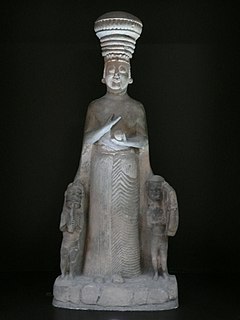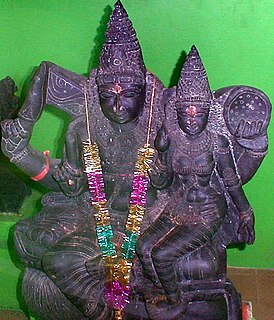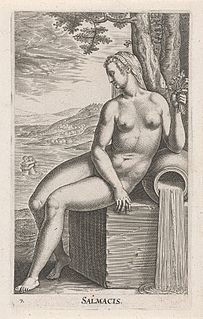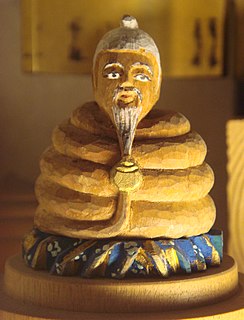 W
WAgdistis was a deity of Greek, Roman and Anatolian mythology, possessing both male and female sexual organs. She is closely associated with the Phrygian goddess Cybele.
 W
WAphroditus or Aphroditos was a male Aphrodite originating from Amathus on the island of Cyprus and celebrated in Athens.
 W
WThe Ardhanarishvara meaning "The Half-female Lord", is a form of the Hindu deity Shiva combined with his consort Parvati. Ardhanarishvara is depicted as half-male and half-female, equally split down the middle. The right half is usually the male Shiva, illustrating his traditional attributes.
 W
WBaphomet is a deity allegedly worshipped by the Knights Templar that subsequently became incorporated into various occult and mystical traditions. The name Baphomet appeared in trial transcripts for the Inquisition of the Knights Templar starting in 1307. It first came into popular English usage in the 19th century during debate and speculation on the reasons for the suppression of the Templars.
 W
WThe Enarei, singular Enaree, were Scythian androgynous/effeminate priests and shamanistic soothsayers.
 W
WGynomorph is a word used to describe an organism with female physical characteristics.
 W
WHapi was the god of the annual flooding of the Nile in ancient Egyptian religion. The flood deposited rich silt on the river's banks, allowing the Egyptians to grow crops. Hapi was greatly celebrated among the Egyptians. Some of the titles of Hapi were "Lord of the Fish and Birds of the Marshes" and "Lord of the River Bringing Vegetation". Hapi is typically depicted as an androgynous figure with a big belly and large drooping breasts, wearing a loincloth and ceremonial false beard.
 W
WIn Greek mythology, Hermaphroditus or Hermaphroditos was a child of Aphrodite and Hermes. According to Ovid, he was born a remarkably handsome boy whom the naiad Salmacis attempted to rape and prayed to be united with forever. A god, in answer to her prayer, merged their two forms into one and transformed him into a hermaphrodite, he being considered the origin of the name. Their name is compounded of his parents' names, Hermes and Aphrodite. He was one of the Erotes.
 W
WIla or Ilā is an androgyne deity in Hindu legends, known for their sex changes. As a man, he is known as Ila or Sudyumna and as a woman, is called Ilā. Ilā is considered the chief progenitor of the Lunar dynasty of Indian kings – also known as the Ailas.
 W
WInari Ōkami , also called Ō-Inari (大稲荷), is the Japanese kami of foxes, fertility, rice, tea and sake, of agriculture and industry, of general prosperity and worldly success, and one of the principal kami of Shinto. In earlier Japan, Inari was also the patron of swordsmiths and merchants. Represented as male, female, or androgynous, Inari is sometimes seen as a collective of three or five individual kami. Inari appears to have been worshipped since the founding of a shrine at Inari Mountain in 711 AD, although some scholars believe that worship started in the late 5th century.
 W
WIn Shinto faith, Kuninotokotachi (国之常立神, Kuninotokotachi-no-Kami, in Kojiki) (国常立尊, Kuninotokotachi-no-Mikoto, in Nihonshoki) is one of the two gods born from "something like a reed that arose from the soil" when the Earth was chaotic. In the Nihon Shoki, he is the first of the first three divinities born after Heaven and Earth were born out of chaos, and is born from something looking like a reed-shoot growing between heaven and earth. He is known by mythology to reside on top of Mount Fuji (富士山).
 W
WLan Caihe is a Chinese mythological figure, and one of the Eight Immortals in the Taoist pantheon. Presence in the Eight makes this figure one of the more familiar out of hundreds of other Taoist immortals. Lan Caihe is the only one of the Eight Immortals whose gender is ambiguous. Lan isn't generally thought to be based on a historical person, but is traditionally said to have been born sometime during the Tang dynasty, and lived as a homeless street entertainer, who wandered all over China, singing philosophical songs. Stories vary about how Lan attained immortality and became one of the Eight Immortals. Lan's emblem is a basket of flowers, and so this immortal is considered the patron of florists and gardeners.
 W
WPhanes or Protogonus was the mystic primeval deity of procreation and the generation of new life, who was introduced into Greek mythology by the Orphic tradition; other names for this Classical Greek Orphic concept included Ericapaeus or Erikepaios and Metis ("thought").
 W
WSalmacis was an atypical Naiad nymph of Greek mythology. She rejected the ways of the virginal Greek goddess Artemis in favor of vanity and idleness.
 W
WŠauška was a Hurrian goddess who was also adopted into the Hittite pantheon. Her name has a Hurrian origin and means the great or magnificent one.
 W
WTlaltecuhtli is a pre-Columbian Mesoamerican deity worshipped primarily by the Mexica (Aztec) people. Sometimes referred to as the "earth monster," Tlaltecuhtli's dismembered body was the basis for the world in the Aztec creation story of the fifth and final cosmos. In carvings, Tlaltecuhtli is often depicted as an anthropomorphic being with splayed arms and legs. Considered the source of all living things, she had to be kept sated by human sacrifices which would ensure the continued order of the world.
 W
WUgajin (宇賀神) is harvest and fertility kami of Japanese Mythology. Ugajin is represented both as a male and a female, and is often depicted with the body of a snake and the head of a bearded man, for the masculine variant, or the head of a woman, for the female variant. In Tendai Buddhism Ugajin was syncretically fused with Buddhist goddess Benzaiten, which became known as Uga Benzaiten or Uga Benten. The goddess sometimes carries on her head Ugajin's effigy.
 W
WVaikuntha-Kamalaja is a composite androgynous form of the Hindu god Vishnu and his consort Lakshmi. Though inspired by the much more popular Ardhanarishvara form of Shiva and Parvati, Vaikuntha-Kamalaja is a rare form, mostly restricted to Nepal and the Kashmir region of India.